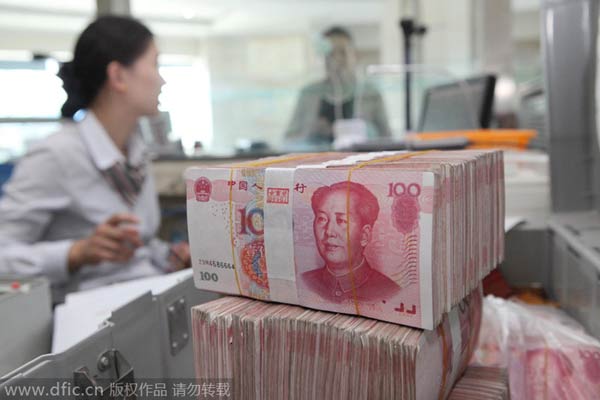China's debt has just turned a corner
Updated: 2015-04-08 07:39
By David Mann(China Daily)
|
||||||||
 |
|
An employee counts renminbi (yuan) banknotes at a bank in Lianyungang city, East China's Jiangsu province, June 4, 2014.[Photo/IC] |
There are fears about China's growth prospects given the recent bad news about weak credit demand, high real interest rates and tight liquidity. But we (at Standard Chartered) see three reasons for at least some optimism:
First, China's debt-to-GDP ratio stabilized in mid-2014, albeit at a relatively high 251 percent of GDP. While China's dramatic debt increase in the past five years grabbed headlines worldwide, as the ratio leapt nearly 100 percentage points from 155 percent of GDP, the fact that the ratio has begun to stabilize has not received much attention.
This is an important milestone in China's debt turnaround following years of excess. Over the past five years, total credit growth in China was on average 8 percentage points faster than nominal GDP growth - way beyond the point at which credit growth becomes inefficient for any economy.
However, since mid-2014, China's credit has been growing in line with GDP. Essentially, this means China is now getting more "bang for its buck" for every new unit of borrowing. Also, attitudes to debt have changed, with loan officials in China now much more averse to taking the risk of a loan going bad.
Although this doesn't mean China's leverage risks have been resolved, because the excessive debt accumulation of prior years still needs to be dealt with, it does mean that debt challenges are no longer escalating. And this is good news.
Resuming past excesses is not an option. China's debt-to-GDP ratio is still relatively high compared with other economies at a similar stage of development, so debt cannot be used to boost growth significantly in the near future without risking even more solvency issues later. Besides, since the official non-performing loan ratio is set to keep rising through 2015 and beyond, most likely not all of the bad debts will be recognized immediately, which comes with both benefits and potential costs.
We will need to watch carefully whether this "ever-greening" of bad loans becomes too large a share of new credit growth. Importantly, this does not appear to be the case so far.
- Global health entering new era: WHO chief
- Brazil's planning minister steps aside after recordings revelation
- Vietnam, US adopt joint statement on advancing comprehensive partnership
- European border closures 'inhumane': UN refugee agency
- Japan's foreign minister calls A-bombings extremely regrettable
- Fukushima impact unprecedented for oceans: US expert

 Stars of Lijiang River: Elderly brothers with white beards
Stars of Lijiang River: Elderly brothers with white beards
 Wealthy Chinese children paying money to learn British manners
Wealthy Chinese children paying money to learn British manners
 Military-style wedding: Fighter jets, grooms in dashing uniforms
Military-style wedding: Fighter jets, grooms in dashing uniforms
 Striking photos around the world: May 16 - May 22
Striking photos around the world: May 16 - May 22
 Robots help elderly in nursing home in east China
Robots help elderly in nursing home in east China
 Hanging in the air: Chongqing holds rescue drill
Hanging in the air: Chongqing holds rescue drill
 2.1-ton tofu finishes in two hours in central China
2.1-ton tofu finishes in two hours in central China
 Six things you may not know about Grain Buds
Six things you may not know about Grain Buds
Most Viewed
Editor's Picks

|

|

|

|

|

|
Today's Top News
Liang avoids jail in shooting death
China's finance minister addresses ratings downgrade
Duke alumni visit Chinese Embassy
Marriott unlikely to top Anbang offer for Starwood: Observers
Chinese biopharma debuts on Nasdaq
What ends Jeb Bush's White House hopes
Investigation for Nicolas's campaign
Will US-ASEAN meeting be good for region?
US Weekly

|

|







